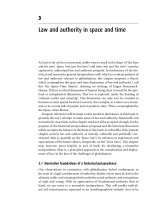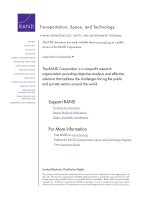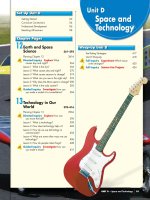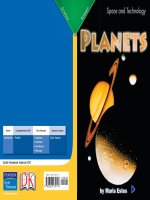3 16 space station life (space and technology)
Bạn đang xem bản rút gọn của tài liệu. Xem và tải ngay bản đầy đủ của tài liệu tại đây (2.7 MB, 10 trang )
Genre
Nonfiction
Comprehension Skill
Compare and
Contrast
Text Features
• Captions
• Labels
• Glossary
Science Content
Solar System
Scott Foresman Science 3.16
ISBN 0-328-13855-X
ì<(sk$m)=bdif f< +^-Ä-U-Ä-U
Vocabulary
Extended Vocabulary
asteroid
orbit
planet
solar system
bicycle ergometer
EMU
iodine
microbes
microgravity
resistance
simulators
What did you learn?
1. When was the International Space
Station started? How is it put
together?
2. What must astronauts wear on
a space walk?
by Stephanie Wilder
3. What kinds of experiments
do astronauts do onboard the
space station?
4.
In this book
you have learned about how
astronauts train to work on the
space station. Write to explain the
training they go through, using
examples from the book.
5.
Compare and Contrast Compare
and contrast the ways you exercise
and relax with the ways astronauts
in space do.
Picture Credits
Every effort has been made to secure permission and provide appropriate credit for photographic material.
The publisher deeply regrets any omission and pledges to correct errors called to its attention in subsequent editions.
Photo locators denoted as follows: Top (T), Center (C), Bottom (B), Left (L), Right (R), Background (Bkgd).
Opener: Human Space Flight/NASA; 1 Marshall Space Flight Center/NASA Image Exchange; 2 Corbis;
4 (B) Marshall Space Flight Center/NASA Image Exchange, (TR) Bill Ingalls/Human Space Flight/NASA;
6 (TR, BL) Human Space Flight/NASA; 7 Kazak Sergei/ITAR-TASS/Corbis; 8 Human Space Flight/NASA;
9 (BR) NASA Image Exchange, (T) Human Space Flight/NASA; 10 Human Space Flight/NASA;
11 (TR) NASA, (BR) Human Space Flight/NASA; 12 Human Space Flight/NASA; 13 (TR) Human Space Flight/NASA;
14 (BL, BR) Human Space Flight/NASA; 15 Human Space Flight/NASA.
Unless otherwise acknowledged, all photographs are the copyright © of Dorling Kindersley, a division of Pearson.
ISBN: 0-328-13855-X
Copyright © Pearson Education, Inc. All Rights Reserved. Printed in the United States of America.
This publication is protected by Copyright, and permission should be obtained from the publisher prior to any
prohibited reproduction, storage in a retrieval system, or transmission in any form by any means, electronic,
mechanical, photocopying, recording, or likewise. For information regarding permission(s), write to
Permissions Department, Scott Foresman, 1900 East Lake Avenue, Glenview, Illinois 60025.
3 4 5 6 7 8 9 10 V010 13 12 11 10 09 08 07 06 05
What You Already Know
The solar system is made
up of the Sun, the nine
planets, and asteroids.
The Sun is a star.
Like most stars, it
is a giant ball of gas.
asteroid
The Sun is 1.4 million
kilometers wide. That’s
109 times wider than the Earth! Energy from
the superhot gases that make up the Sun heats
the nine planets.
The nine planets that orbit around the
Sun are Mercury, Venus, Earth, Mars, Jupiter,
Saturn, Uranus, Neptune, and Pluto.
Asteroids are chunks of rock that also orbit
around the Sun. They are mostly found in a
belt between Mars and Jupiter. This asteroid
belt breaks the planets into two groups.
Mercury, Venus, Earth, and Mars are the inner
planets. Jupiter, Saturn, Uranus, Neptune, and
Pluto are the outer planets.
2
Most of the planets are made of rock, like
Earth. But some are made of gas like the Sun.
These planets are called the gas giants. They are
Jupiter, Saturn, Uranus, and Neptune.
Of the nine planets, only Earth can support
a wide variety of living things. Advances in
science now let astronauts explore more of the
solar system.
In this book you will learn about the lives
of the astronauts who live and work aboard the
International Space Station. They orbit around
Earth and study our solar system from space.
Saturn is a gas giant.
3
A View From Above
Sixteen countries, including the United States
and Russia, work on building and maintaining
the International Space Station. In 1998, the first
two parts of the station were launched. In 2000,
astronauts, who are also scientists, began living
and working on the space station.
The International Space Station orbits Earth
about 16 times a day. It is around 360 kilometers
above Earth. Its astronauts gather data, do
experiments, and learn to live without gravity.
The information they send back to Earth helps us
understand more about life in space.
The International
Space Station orbits
high above Earth.
4
The space station cabin is
about the size of a threebedroom house. Three
astronauts live in the cabin at a
time. The astronauts work,
sleep, and eat in the same few
rooms. They even exercise in
the space station! The space
waving good-bye station’s lack of gravity makes
even basic activities very difficult.
Astronauts need to go on space walks, or
trips outside the space station, to fix parts of
the station or to add new parts to it. Astronauts
need protection when they go on space walks.
They get this protection from special suits
called Extravehicular Mobility Units, or EMUs.
These special suits keep astronauts’ bodies
under the correct temperature and pressure
conditions, and provide them with air. The
EMUs also have jet
packs so astronauts
can return to the
station in an
emergency.
5
Getting Ready
Astronauts go through
a lot of training before
they can live aboard the
space station. Simulators
are used on Earth to show
Astronauts practice with
astronauts what their
work will be like in space. zero-gravity conditions
on special aircraft.
They learn to control a
model of the space station’s robotic arm
and practice the things they will need to
do on space walks.
Even though the International Space Station
was started in 1998, parts of it are still being built.
Some of these parts are
added in space! When
the space station is done
it will have six
laboratories and weigh
over one million pounds.
Training for Extravehicular
Activity is done in
underwater tanks.
6
Different countries are
making different parts of the
space station. When a piece is
finished, either the United
States or Russia sends it into
space. Scientists think it will
require 44 trips to take all the
parts into space.
Lots of special tools are
this is a caption this is a
captionthis
is a the new parts to
needed
to add
the space station. Astronauts
use robots to do some of the
work. They also use special
hand tools that work in space.
When it is finished, the space
station will have about
one hundred sections
all bolted together.
It will be able to
support a crew
of seven
astronauts.
this is a caption
this is a captionthis
7
Maintenance
In order to finish
building the space station,
astronauts must go on
space walks to put the
pieces together. It will take
around 160 space walks to
complete the station. The
Space stations need
a lot of maintenance. astronauts use robots to
help with some of the
work. Robotic arms are particularly useful.
They help astronauts to move large pieces of
the station. All of this work is done using
tools and robots the astronauts practiced
using on Earth.
Astronauts are always fixing small problems
on the space station. When small problems are
taken care of right away, fewer big problems
develop! It is expensive and risky to make trips to
the space station. Not very many trips are made
each year. That means the astronauts on the
International Space Station need to fix most
problems on their own!
8
Astronauts must wear
special spacesuits to
protect them during
space walks.
Astronauts enter the
space station through
a special “doorway” called
an “airlock.”
9
Space Science
Astronauts aboard the International Space
Station are figuring out better ways for humans
to live in space. They are also doing research that
is important to life on Earth today. One of the
ways the astronauts learn about life in space is
by conducting experiments.
Microgravity is the very slight amount of
gravity felt while in orbit. Experiments in
microgravity help astronauts understand all
kinds of things about human biology. They
observe things about the human body that can’t
be studied on Earth.
Microgravity Science
Gloveboxes, such as this
one, help astronauts carry
out experiments.
A candle flame
in space looks
very different
because of
zero gravity.
flame on Earth
flame in space
In space, materials burn very differently than
they do on Earth. By studying how fire and flames
behave in space, astronauts can learn how to
better fight fires. They also hope to learn how
cleaner-burning furnaces can be constructed.
Astronauts on the space station use gloveboxes,
similar to the one shown, to conduct experiments
with fire safely. It is also useful for astronauts to
study plant life in space. Then they can learn how
plants grow and change in microgravity. Besides
studying the effects of
microgravity, scientists hope to
study Earth from space. They
want to learn things about our
world they couldn’t learn on
the ground.
Space station research
includes the study of
growing plants.
10
11
Everyday Life
Microgravity is great for scientific research.
Unfortunately, it makes everyday life a little tricky.
Everything that the astronauts eat must be
stored aboard the space station. Their food must
last for months on end, so water is removed.
Water is a very important resource on the space
station. Since the supply is limited, it must be
recycled and reused. Astronauts need to drink
lots of water since it is taken out of their food.
Astronauts must add iodine to their water to keep
away microbes that can make them sick.
Exercise is a very
important part of life on
the space station.
Microgravity causes muscles
and bones to become weak,
since they are not used as
much. That means astronauts
need to exercise a lot while
in space to stay healthy. They
exercise at least once a day
Astronauts must
while on a mission.
exercise constantly in
You cannot lift weights
order to stay healthy
in space for exercise. In
in space.
microgravity, weights don’t
weigh anything! So, for exercise, astronauts
use resistance. They strap themselves into
a treadmill and use something called a bicycle
ergometer. A bicycle ergometer is similar to a
stationary bicycle. It is bolted to the floor and
has a seat belt. On a bicycle ergometer,
astronauts can pedal with their feet just like
on Earth. Or they can stand on the ceiling
and pedal with their arms! Microgravity
allows astronauts to exercise in unusual ways.
Food can be difficult to eat in space.
12
13
Taking It Easy
The astronauts aboard the space station are
given lots of time to relax each day. They can
read books, watch movies, and call or e-mail
home. They can also enjoy the special view of
Earth from the station’s cockpit window.
After work and relaxation comes sleep, of
course. Sleeping in space is a little different from
sleeping on Earth. Instead of a bed, astronauts
sleep in special sleeping bags that are attached to
the wall. It may seem strange, but astronauts
would float around the cabin if they did not sleep
this way! These sleeping bags even have arm
straps so that astronauts’ arms don’t start floating
while they sleep.
This astronaut is sending
an e-mail message.
14
Some astronauts play
music to help them relax.
A spacecraft docks to allow for an exchange of crews.
Crew Exchange
After a few months, the space station’s old
crew gets replaced by a new crew. The new crew
must bring all their own food and any supplies
the space station needs. The old crew updates
the new crew on all the changes made to the
space station. Once the new crew is in place,
the old crew can return to Earth and continue
their normal lives!
15
Vocabulary
Glossary
asteroid
Extended Vocabulary
bicycle ergometer
orbit
EMU
planet ergometer a piece
iodine
bicycle
of exercise
solar system
microbes
equipment, like a bicycle,
usedmicrogravity
by astronauts in space
resistance
EMU
Extravehicular
simulators Mobility
Units, worn by astronauts
when working outside the
space station
iodine
microbes
a chemical element used to
make drinking water safe
What did you learn?
1. When was the International Space
Station started? How is it put
together?
2. What must astronauts wear on
a space walk?
3. What kinds of experiments
do astronauts do onboard the
space station?
4.
In this book
you have learned about how
astronauts train to work on the
space station. Write to explain the
training they go through, using
examples from the book.
5.
Compare and Contrast Compare
and contrast the ways you exercise
and relax with the ways astronauts
in space do.
tiny living things that can
cause disease
Picture Credits
Every effort has been made to secure permission and provide appropriate credit for photographic material.
The publisher deeply regrets any omission and pledges to correct errors called to its attention in subsequent editions.
microgravity
an environment where there
Photo locators denoted as follows: Top (T), Centeris
(C), Bottom
(B), Left (L),
(R), Background (Bkgd).
almost
noRightgravity
Opener: Human Space Flight/NASA; 1 Marshall Space Flight Center/NASA Image Exchange; 2 Corbis;
4 (B) Marshall Space Flight Center/NASA Image Exchange, (TR) Bill Ingalls/Human Space Flight/NASA;
6 (TR, BL) Human Space Flight/NASA; 7 Kazak Sergei/ITAR-TASS/Corbis; 8 Human Space Flight/NASA;
9 (BR) NASA Image Exchange, (T) Human Space Flight/NASA; 10 Human Space Flight/NASA;
11 (TR) NASA, (BR) Human Space Flight/NASA; 12 Human Space Flight/NASA; 13 (TR) Human Space Flight/NASA;
14 (BL, BR) Human Space Flight/NASA; 15 Human Space Flight/NASA.
resistance
to push with force against
something
Unless otherwise acknowledged, all photographs are the copyright © of Dorling Kindersley, a division of Pearson.
simulators
ISBN: 0-328-13855-X
machines that re-create
space station conditions
for practice
Copyright © Pearson Education, Inc. All Rights Reserved. Printed in the United States of America.
This publication is protected by Copyright, and permission should be obtained from the publisher prior to any
prohibited reproduction, storage in a retrieval system, or transmission in any form by any means, electronic,
mechanical, photocopying, recording, or likewise. For information regarding permission(s), write to
Permissions Department, Scott Foresman, 1900 East Lake Avenue, Glenview, Illinois 60025.
16
3 4 5 6 7 8 9 10 V010 13 12 11 10 09 08 07 06 05









